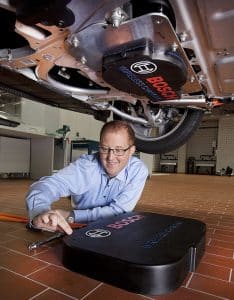Professor Andreas Grzemba about which direction electric transportation will or could take in the future: “We won’t need any cords or our hands to charge electric vehicles.” Today, many experts believe the cord is the best solution to charge car batteries. But as technical manager of the German E-WALD research project, Grzemba thinks that autonomous driving and inductive charging will become two sides of the same coin and the standard over time. E-WALD has been the basis for developing the first approved wireless fast-charge induction system.
The demonstration project for inductive charging was launched in early 2015 at the Deggendorf Institute of Technology with the aim of simplifying electric vehicle charging and providing a more user-friendly experience. One crucial pillar of the project is fast-charging, as most common 3.7-kilowatt induction systems replenish a battery at a much slower pace than units with 22 kilowatts and more.
Thanks to the new IN-DEG system, the university succeeded in lowering inductive charging times from an initial six hours to under half an hour. The only requirement for increasing the speed has been to park the car on top of the charging pad by using an integrated positioning system (tolerance: ± 8 centimeters or around 3.1 inches). When the car is in the right spot, charging will begin automatically after you turn off the ignition. Less than 30 minutes later, the battery is at 80 per cent capacity.
The test vehicles, a Nissan Leaf and a Citroën Berlingo, had been retrofitted for the task with the help of Integrated Infrastructure Solutions, which contributed their know-how of systems used in the magnetic levitation train Transrapid. The scientific evaluation accompanying the tests mainly focused on safety, particularly on the electromagnetic radiation emanating from the underbody. The researchers took 3D measurements to ensure that exposure limits were observed.
E-WALD among top 100
Every year, Germany recognizes the one hundred most innovative businesses operating across the country. In 2016, E-WALD moved into the top 100 and received the award from the hands of business journalist and TV host Ranga Yogeshwar during the German SME Summit in Essen on June 24, 2016.
E-WALD used to be a support program titled “Electric Transportation – Bavarian Forest.” It led to the establishment of E-WALD GmbH, which was founded in Teisnach in 2012 and employs 15 staff.
Transformer on the inside
Energy transfer is based on the principle of electromagnetic induction, which was discovered by British physicist Michael Faraday in 1831. The method is also used in transformers, where two coils are linked by a ferromagnetic core. An alternating current passing through the primary coil produces a changing electromagnetic field in the core. This AC field induces an alternating voltage in the secondary coil. A rectifier is then used to provide direct current for battery charging. This works even if the coils are at a distance from each other, as in the case of electric vehicle charging or electric toothbrushes. The only on-the-road experiences with the technology have been made in Italy, where …



























0 Comments